SPACE
Star-studded snake-like galaxy shines in gorgeous Hubble Telescope photoSharmila Kuthunur
Sat, October 7, 2023
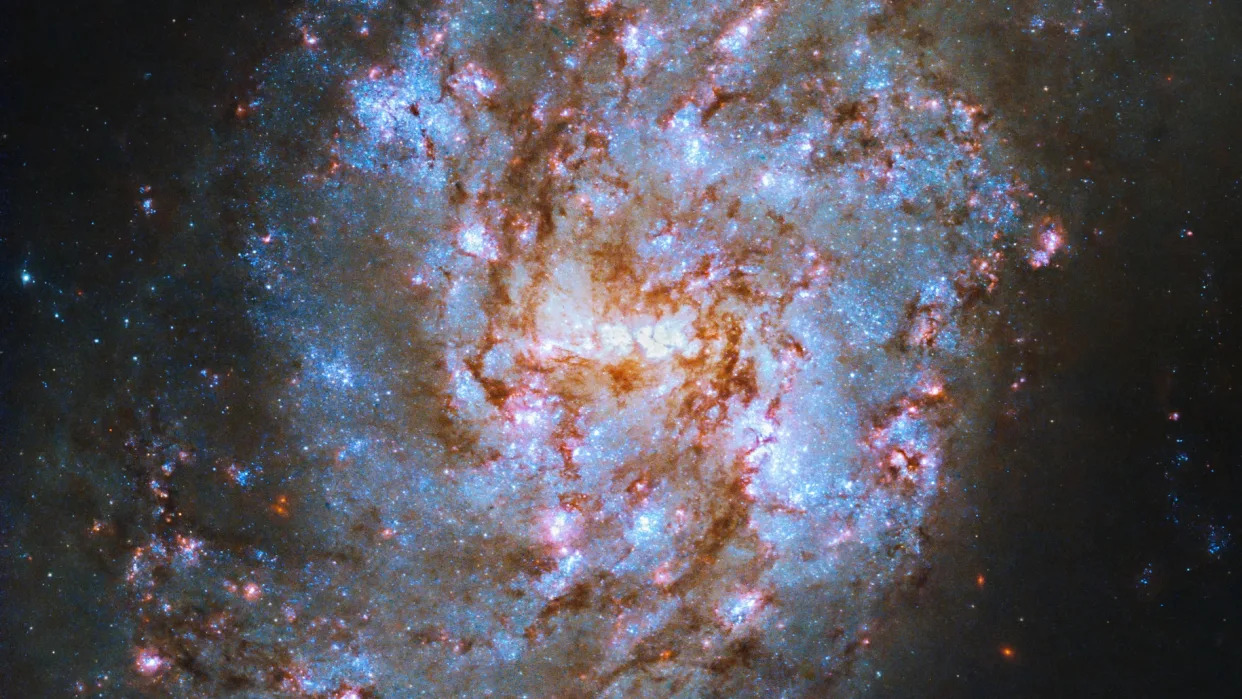
Star-studded snake-like galaxy shines in gorgeous Hubble Telescope photo
A new Hubble Space Telescope image shines a spotlight on a faraway snake-like galaxy whose swirling arms feature new and old stars.
Light from this galaxy started its journey to Earth roughly 80 million years ago, long before the dinosaurs died out. The image, released as part of NASA's Hubble Galaxy Week from Oct. 2 to Oct. 7, features NGC 1087, a spiral galaxy residing in the constellation Cetus. This particular patch of sky is named after a mythical Greek sea monster and is home to the popular Aquarius and Pisces constellations.
The broken tendrils of red light indicate cold molecular gas, which is the raw ingredient from which new stars form and grow across eons. Comparatively, the blue regions host hot stars formed in the past. Astronomers think many of them are of a rare class of highly unstable stars called Wolf-Rayet.
Related: Hubble Space Telescope: Pictures, facts & history
Despite all the shine, the galaxy has just one known star that went supernova in August 1995, which is also when astronomers noticed a brief spike in the galaxy's brightness.
NGC 1087's most notable feature, however, is its bright-white starry bar at the center of its twisted trails of gas. Here, surprising hints of birthing stars make the galaxy an exciting object for astronomers to study. The bar itself is similar but much shorter compared to the central bar of our very own Milky Way.
Our location within the Milky Way makes it very difficult to precisely estimate the size and shape of this central bar, so galaxies like NGC 1087 that sport similar features are valuable targets to observe.
When seen from our skies, NGC 1087 can be spotted just south of the celestial equator, which means it is visible from both the northern and southern hemispheres.According to a statement accompanying the newly released image, astronomers use Hubble, which launched to Earth orbit in 1990, to learn about what happens to pockets of gas after stars form within them (among many other projects).
Hubble Telescope just witnessed a massive intergalactic explosion and astronomers can't explain it
Keith Cooper
Fri, October 6, 2023

A mysterious cosmic explosion created a brilliant flash of light in the space between two galaxies over 3 billion light-years away.
The optical flash, which was one of the brightest bursts of blue light in the universe but lasted only a few days, is the latest example of a rare breed of brief astronomical event called a luminous fast blue optical transient (LFBOT).
LFBOTs are a complete mystery. The first one to be discovered wasn't observed until 2018. Designated AT2018cow, it was positioned in the spiral arm of its galaxy 200 million light-years away. Nicknamed "the Cow," it was up to 100 times brighter than an ordinary supernova, and was also bright in radio waves, ultraviolet and X-rays. If it was a supernova, it behaved very oddly. Usually, a supernova stays bright for weeks, or even months, and has a recognizable spectrum. Yet the Cow faded after a few days.
Similar bursts of light are discovered at a rate of about one per year, and they are nicknamed after animals based on the last three letters in their designation. Other LFBOTs have been dubbed the Camel, the Koala and the Tasmanian Devil. This latest LFBOT, detected by the Zwicky Transient Facility at Palomar Observatory in California on April 10, is designated AT2023fhn and, consequently, has been nicknamed "the Finch."
After the LFBOT's initial detection, a preplanned sequence of observations by telescopes on the ground and in space was enacted. The Gemini South telescope in Chile measured the Finch's spectrum and found that it was 20,000 degrees Celsius (about 36,000 degrees Fahrenheit) — which is hot, but not as hot as some massive stars and certainly not as hot as a supernova. Redshift measurements place it about 3 billion light-years away, a huge distance at which only the Hubble Space Telescope could resolve its host galaxy.
And when it did, astronomers made a shocking observation: Finch was not in a galaxy at all.
All previous LFBOTs have been observed in the spiral arms of galaxies, but Hubble observed that the Finch was in intergalactic space, about 50,000 light-years from one large spiral galaxy and 15,000 light-years from a small galaxy.
The optical flash, which was one of the brightest bursts of blue light in the universe but lasted only a few days, is the latest example of a rare breed of brief astronomical event called a luminous fast blue optical transient (LFBOT).
LFBOTs are a complete mystery. The first one to be discovered wasn't observed until 2018. Designated AT2018cow, it was positioned in the spiral arm of its galaxy 200 million light-years away. Nicknamed "the Cow," it was up to 100 times brighter than an ordinary supernova, and was also bright in radio waves, ultraviolet and X-rays. If it was a supernova, it behaved very oddly. Usually, a supernova stays bright for weeks, or even months, and has a recognizable spectrum. Yet the Cow faded after a few days.
Similar bursts of light are discovered at a rate of about one per year, and they are nicknamed after animals based on the last three letters in their designation. Other LFBOTs have been dubbed the Camel, the Koala and the Tasmanian Devil. This latest LFBOT, detected by the Zwicky Transient Facility at Palomar Observatory in California on April 10, is designated AT2023fhn and, consequently, has been nicknamed "the Finch."
After the LFBOT's initial detection, a preplanned sequence of observations by telescopes on the ground and in space was enacted. The Gemini South telescope in Chile measured the Finch's spectrum and found that it was 20,000 degrees Celsius (about 36,000 degrees Fahrenheit) — which is hot, but not as hot as some massive stars and certainly not as hot as a supernova. Redshift measurements place it about 3 billion light-years away, a huge distance at which only the Hubble Space Telescope could resolve its host galaxy.
And when it did, astronomers made a shocking observation: Finch was not in a galaxy at all.
All previous LFBOTs have been observed in the spiral arms of galaxies, but Hubble observed that the Finch was in intergalactic space, about 50,000 light-years from one large spiral galaxy and 15,000 light-years from a small galaxy.
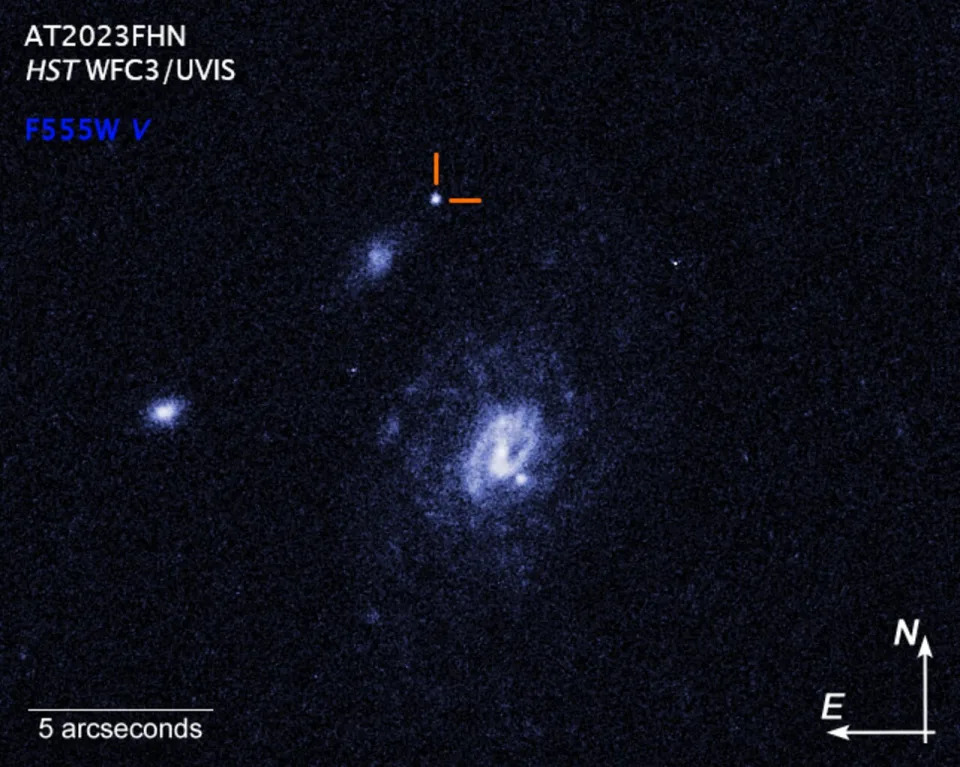
Its location would seem to go against the possibility that it could be the supernova of an exploding massive star. While there are rogue stars that get flung out of a galaxy and into intergalactic space following an encounter with a supermassive black hole, massive stars live only a few million years before going supernova, which is not enough time for a star to get all the way out there.
"The more we learn about LFBOTs, the more they surprise us," Ashley Chrimes, a research fellow at the European Space Agency and lead author of a new paper describing the recently observed LFBOT, said in a statement. "We've shown that LFBOTs can occur a long way from the center of the nearest galaxy, and the location of the Finch is not what we expect for any kind of supernova."
Chrimes and his team are focusing on two possible explanations. One is that the Finch was a flash of light caused by a star being ripped apart by an intermediate-mass black hole, which is a black hole with a mass between 100 and a few thousand times the mass of the sun. Intermediate-mass black holes are thought to reside at the cores of some globular star clusters, which lurk on the outskirts of galaxies. Chrimes plans to eventually use the powerful optics of the James Webb Space Telescope to search for any faint globular clusters in the same location as the Finch.
Alternatively, the Finch might have been a kilonova, which is the explosion resulting from the collision of two neutron stars (or sometimes between a neutron star and a black hole). The Laser Interferometer Gravitational-Wave Observatory was not operating at the time to detect any possible gravitational waves, or ripples in spacetime,from a neutron star merger (its latest observing run began in May). And at 3 billion light-years away, the Finch may have been too distant to detect anyway. No associated gamma-ray burst was detected.
"The discovery poses many more questions than it answers," Chrimes said. "More work is needed to figure out which of the many possible explanations is the right one."
The findings have been accepted for publication in the journal Monthly Notices of the Royal Astronomical Society.
Hubble Telescope reveals a rare galaxy with a luminous heart (photo)
Monisha Ravisetti
Thu, October 5, 2023
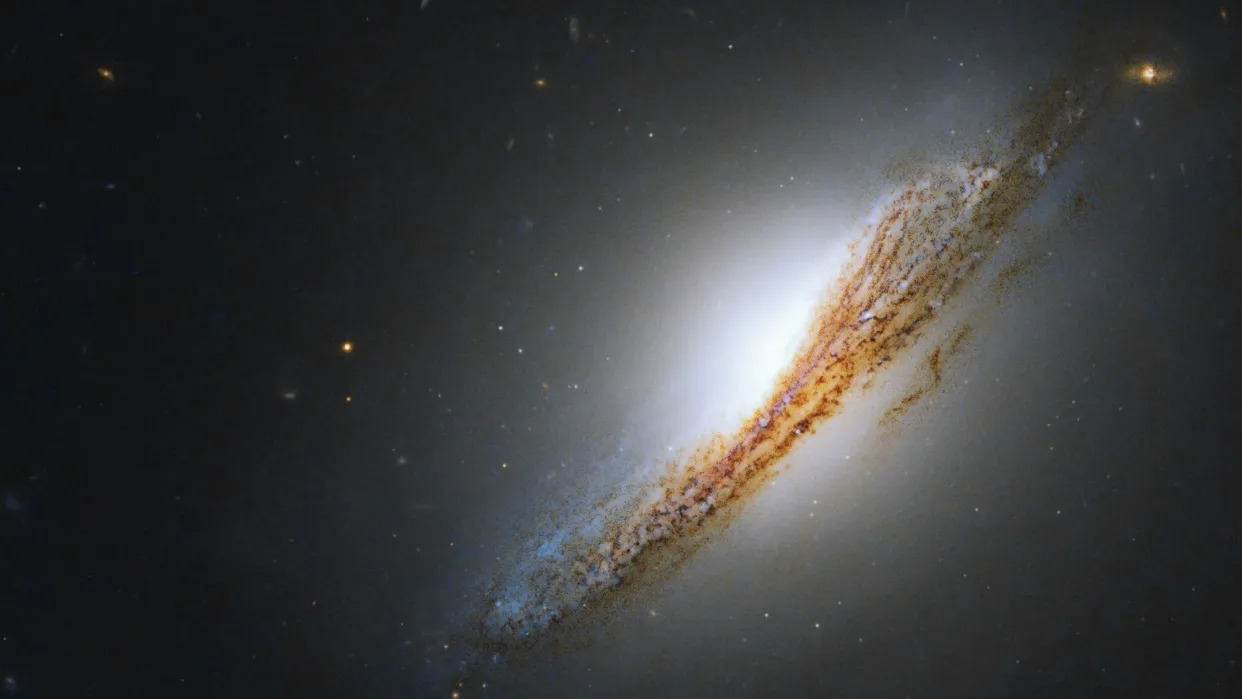
If you thought imagining the scale of our sun is stressful — it's 333,000 times more massive than the entire Earth — you'll be pleased to know the Hubble Space Telescope has reminded us of something even bigger. There's a galaxy out in space that's 1.1 trillion times more massive than our host star. It's named NGC 612, and we now have a new image of it.
Well, if it makes you feel any better, NGC 612 isn't as big as the Milky Way. The galaxy we live in is approximately 1.5 trillion times more massive than the sun. Or… maybe that didn't help.
According to a new release about the new NGC 612 visual, this galaxy falls under a few classifications that make it particularly interesting for us to observe. Most interestingly (in my opinion, at least), it's an active galaxy. In active galaxies, a supermassive black hole powers up the central region to create an incredibly energetic galactic heart. This heart, in turn, spews out jets of gas at nearly the speed of light. As a result of all that, the central spot also becomes so luminous that it outshines the combined light of every single star in the galaxy itself. Stunning.
Related: Chinese astronomers say their new space telescope will outdo Hubble
Though the Hubble Space Telescope's new view of NGC 612 is edge-on, meaning we're seeing it from a side angle, it's easy to infer the spectacle happening in the middle. Notably, there's also a so-called "central bulge" in that area as well. By contrast, orange and dark red zones in this image represent a plane of matter called the "galactic disk." That's where dust and cool hydrogen gas are located, and where star formation (albeit sparse) happens for NGC 612. Together, the bulge, disk and lack of spiral arms reveal this galaxy to be a lenticular galaxy — which is key for something we'll get to later.
The release also highlights how NGC 612 is a Seyfert galaxy, which means it emits large amounts of infrared radiation despite also being seen in visible light. Infrared wavelengths are a form of light that's invisible to human eyes. On the bright side, however, we have instruments that can pick up infrared signals to reveal those hidden sources, such as the James Webb Space Telescope and of course the Hubble Space Telescope, which is how this image was, in part, constructed.
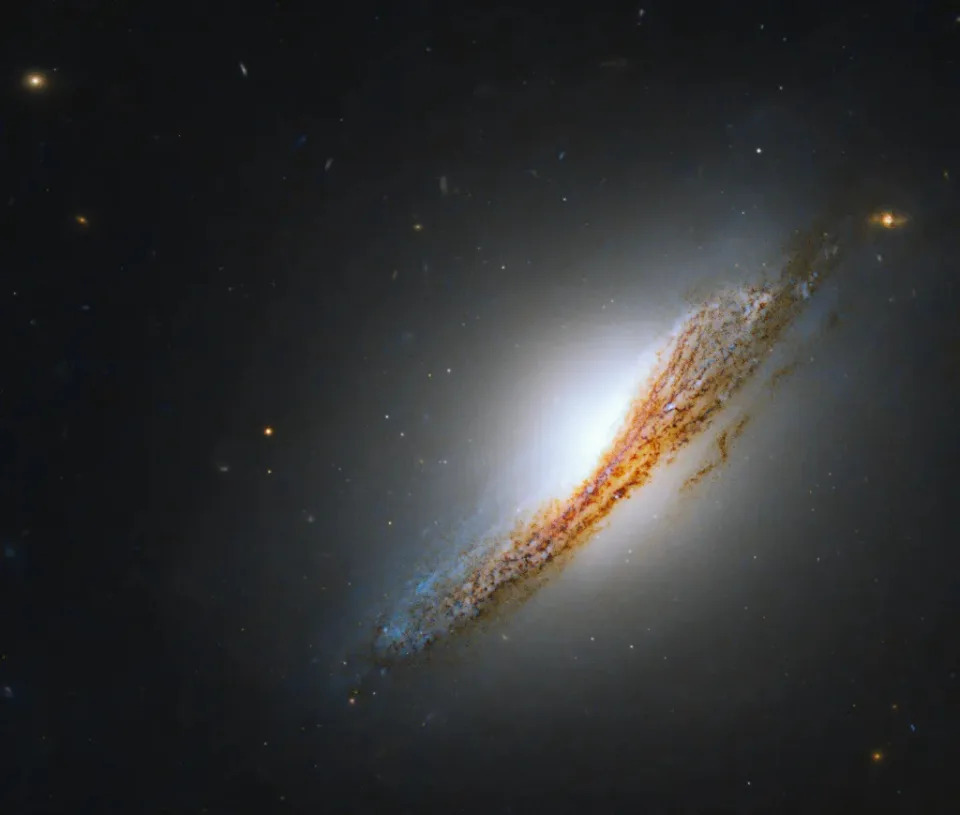
"NGC 612 is a Type II Seyfert," the release further states, "which means matter near the center of the galaxy moves rather calmly around the nucleus. The stars in this galaxy are unusually young, with ages around 40 to 100 million years."
Returning to that lenticular bit: This galaxy is a rare example of a non-elliptical galaxy that beams out radio emissions. Astronomers have only discovered five radio-emitting lenticular galaxies like this one to date. "One theory attributes NGC 612’s unusual radio emissions to a past interaction with a companion spiral galaxy," the release states. "Another theory focuses on the galaxy’s bright and dominant bulge, which is similar to those seen in elliptical radio galaxies."
This Hubble Telescope galaxy image could help reveal how stars are born (photo)
Monisha Ravisetti
Thu, October 5, 2023
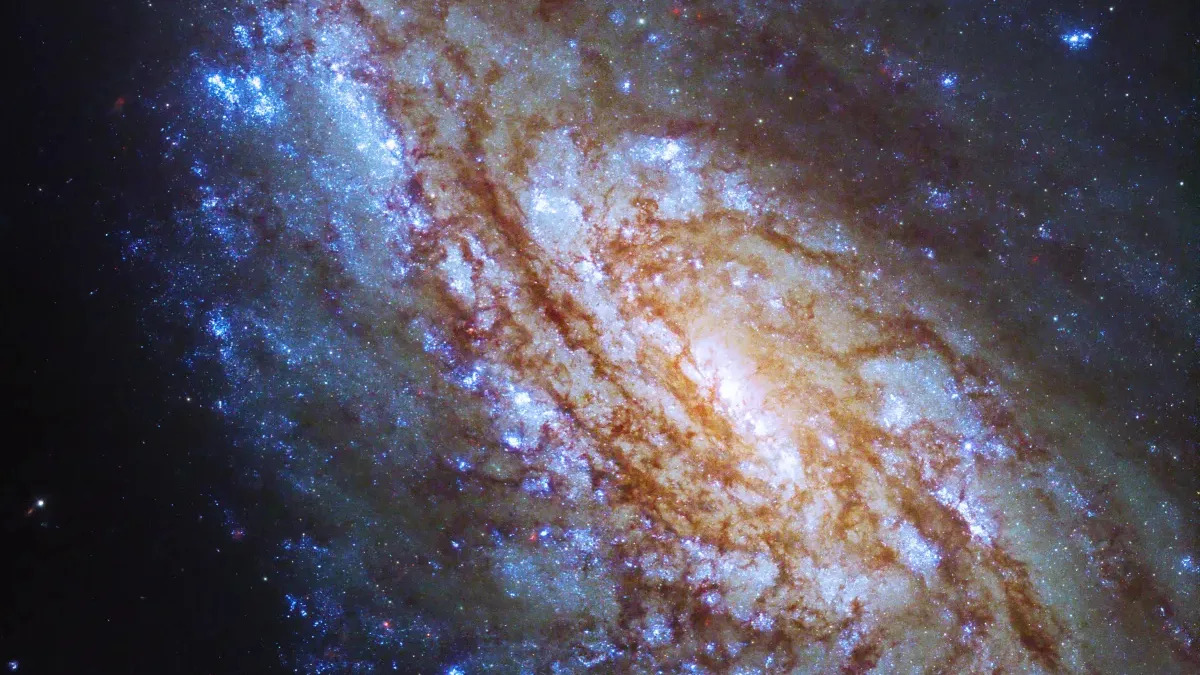
With its fluorescent blues and espresso-brown hues, this Hubble Space Telescope image of the Virgo Cluster galaxy is undeniably worth a double-take. It's part of NASA's endeavor to share a new galactic image every day from Oct. 2 and Oct. 7, a lovely treat for space-gazers everywhere.
But, like with all beautiful space visuals, the book behind the stars is often just as striking as the cover.
What you're looking at here are the swirling spiral arms of a galaxy named NGC 4654, which is located some 55 million light-years from Earth. Right off the bat, that means we're seeing this realm as it was 55 million years ago, because one light-year equals the time it takes for light to travel one year. Once this galaxy's photons finally reached the Hubble Space Telescope, the observatory was able to capture their source in visible, ultraviolet and even infrared wavelengths. And this image is the product of its effort.
Over 500 million years ago, according to a statement accompanying the image, NGC 4654 is believed to have interacted with another galaxy known as NGC 4639, and the latter is thought to have stripped the former of some gas along its edge. Presumably, that happened as a result of NGC 4639's gravitational pull. Ultimately, scientists think this interaction limited star formation at NGC 4654's edge because all that interstellar gas contains the parts required to make new generations of stars in the first place.
In fact, that's why NASA says studying galaxies like this stunning one we see in the Hubble photo is important. It's a way to investigate how stars form. And understanding how stars form is crucial for a variety of reasons — for example, it could help us study how planets are born around stars the way Earth came together around the sun.
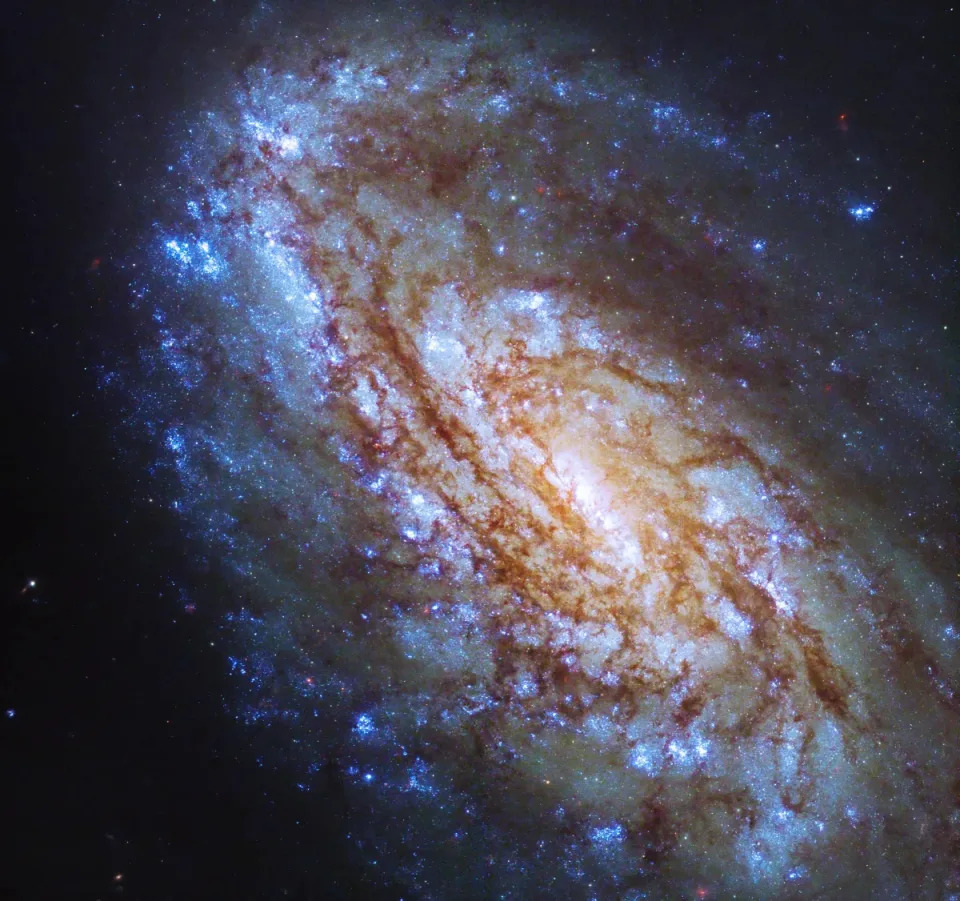
NGC 4654 is one of many galaxies in the Virgo constellation, a celestial dot-to-dot that's actually the second-largest constellation in the sky. Visible to anyone in the northern hemisphere and to most in the southern hemisphere (though not exactly very easily), NGC 4654 is considered an "intermediate" galaxy because it contains two types of hypnotic arms — barred and unbarred.
Barred spirals have ribbons of stars, gas and dust that cut across their central regions like, yes, "bars." Unbarred spirals do not.
Further, the release states, NGC 4654 has an asymmetric distribution of stars and neutral hydrogen gas — possibly due to a process where the entire Virgo cluster puts pressure on the galaxy as it moves through what's known as the intracluster medium. That's basically a superheated plasma, or ocean of charged particles, made mostly of hydrogen.
"This pressure feels like a gust of wind – think of a biker feeling wind even on a still day — that strips NGC 4654 of its gas," the release says. Peculiarly, that process also is expected to have halted star formation in the galaxy, yet NGC 4654 appears to have popped up stellar bodies at a similar rate to its unaffected galactic siblings. Voila: There's another reason to figure out the connection between cold gas in galaxies and star formation.
A friendly reminder that even though other telescopes have earned the spotlight recently, most notably the James Webb Space Telescope, Hubble is still wonderfully trudging along.
Scientists untangle mystery about the universe's earliest galaxies
Will Dunham
Fri, October 6, 2023
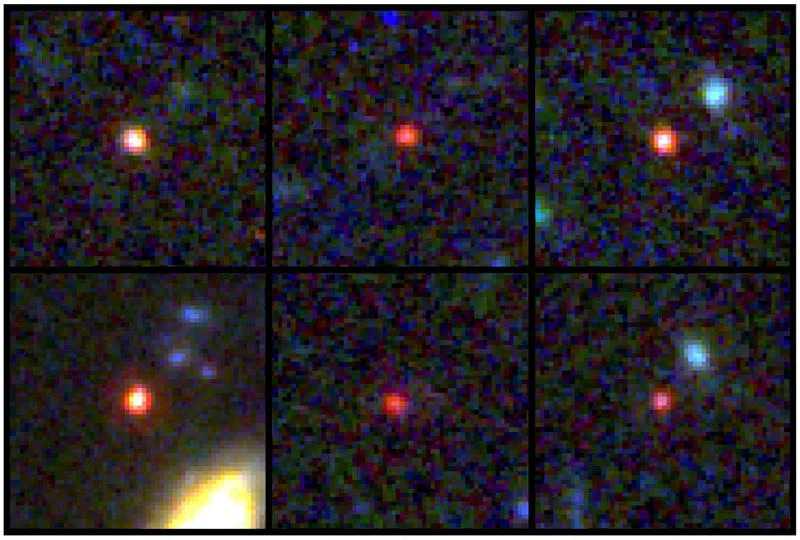
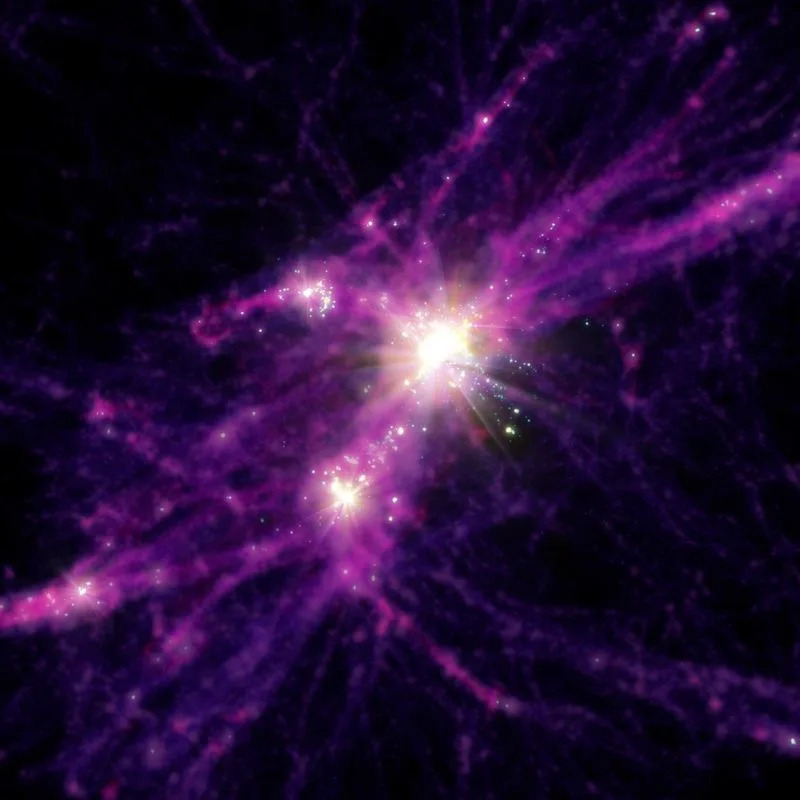
Artist's conception of star bursting galaxies early in the history of the universe is shown
WASHINGTON (Reuters) - Since beginning operations last year, the James Webb Space Telescope has provided an astonishing glimpse of the early history of our universe, spotting a collection of galaxies dating to the enigmatic epoch called cosmic dawn.
But the existence of what appear to be massive and mature galaxies during the universe's infancy defied expectations - too big and too soon. That left scientists scrambling for an explanation while questioning the basic tenets of cosmology, the science of the origin and development of the universe. A new study may resolve the mystery without ripping up the textbooks.
The researchers used sophisticated computer simulations to model how the earliest galaxies evolved. These indicated that star formation unfolded differently in these galaxies in the first few hundred million years after the Big Bang event 13.8 billion years ago that initiated the universe than it does in large galaxies like our Milky Way populating the cosmos today.
Star formation in the early galaxies occurred in occasional big bursts, they found, rather than at a steady pace. That is important because scientists typically use a galaxy's brightness to gauge how big it is - the collective mass of its millions or billions of stars.
So, according to the study, these galaxies may have been relatively small, as expected, but might glow just as brightly as genuinely massive galaxies do - giving a deceptive impression of great mass - because of brilliant bursts of star formation.
"Astronomers can securely measure how bright those early galaxies are because photons (particles of light) are directly detectable and countable, whereas it is much more difficult to tell whether those galaxies are really big or massive. They appear to be big because they are observed to be bright," said Guochao Sun, a postdoctoral fellow in astronomy at Northwestern University in Illinois and lead author of the study published this week in the Astrophysical Journal Letters.
Webb, which was launched in 2021 and became operational in 2022, detected about 10 times more very bright galaxies from cosmic dawn than anticipated based on most theoretical models.
"According to the standard model of cosmology, there should not be many very massive galaxies during cosmic dawn because it takes time for galaxies to grow after the Big Bang. Immediately after the Big Bang, the universe was filled with a very hot, nearly uniform plasma - a fireball - and there were no stars or galaxies," Northwestern University astrophysicist and study senior author Claude-André Faucher-Giguère said.
"In our new paper, we show quantitatively using our simulations that the bursts of star formation produce flashes of light that can explain the very bright galaxies observed by Webb. And the reason this is so significant is that we explain these very bright galaxies without having to break the standard cosmological model," Faucher-Giguère added.
The simulations in the study were conducted as part of the Feedback of Relativistic Environments (FIRE) research project.
The findings centered upon a phenomenon called "bursty star formation."
"In contrast to forming stars at a nearly constant rate, the star formation activity in those early galaxies went on-and-off, on-and-off, with some large fluctuations over time. This, in turn, drives large variations in their brightness because the light seen by telescopes like JWST was emitted by the young stars formed in those galaxies," Sun said.
The researchers have an idea of why this phenomenon occurs in smaller galaxies. In these, a batch of very large stars may form in a sudden burst, then explode as supernovas after just a few million years due to their great size. They blast gas into space that becomes ingredients for another burst of star formation. But the stronger gravitational effects in larger galaxies prevent these bursts, favoring steady star formation.
Sun expects Webb to continue to challenge our understanding of the universe and provide fresh insight, regardless of whether it meets scientific expectations.
"This is exactly how science is done and progressed," Sun said.
(Reporting by Will Dunham, Editing by Rosalba O'Brien)
No comments:
Post a Comment